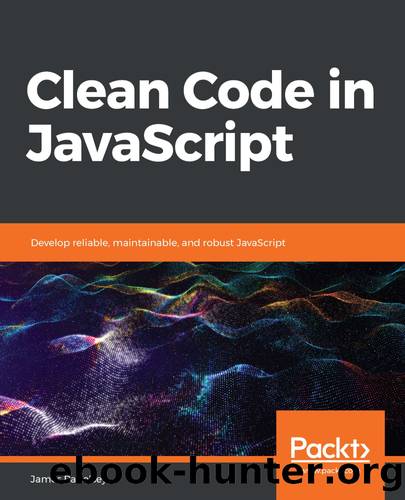Clean Code in JavaScript by James Padolsey

Author:James Padolsey [James Padolsey]
Language: eng
Format: epub
Tags: COM060160 - COMPUTERS / Web / Web Programming, COM070000 - COMPUTERS / User Interfaces, COM051300 - COMPUTERS / Programming / Algorithms
Publisher: Packt
Published: 2020-01-17T13:13:58+00:00
// Reconstruction:
const skyline = {name, ...attributes};
skyline; // => { name: "Nissan Skyline", engineSize: "2500cc", year: 2009 }
When used in this context, the value of the right side of the spread syntax must be either an object or a primitive that can be wrapped as an object (for example, Number or String). This means that all values in JavaScript are permissible except null and undefined, both of which, as we know, cannot be wrapped as objects:
let {...stuff} = null; // => TypeError
It's, therefore, best to only use the spread syntax in an object context when you're confident that the value is an object.
In conclusion, the spread syntax, as we've seen, is remarkably useful in a variety of different situations. Its main advantage is that it reduces the amount of syntax required to extract and designate values.
Download
This site does not store any files on its server. We only index and link to content provided by other sites. Please contact the content providers to delete copyright contents if any and email us, we'll remove relevant links or contents immediately.
Hello! Python by Anthony Briggs(10198)
The Mikado Method by Ola Ellnestam Daniel Brolund(10106)
OCA Java SE 8 Programmer I Certification Guide by Mala Gupta(10043)
Algorithms of the Intelligent Web by Haralambos Marmanis;Dmitry Babenko(8588)
Sass and Compass in Action by Wynn Netherland Nathan Weizenbaum Chris Eppstein Brandon Mathis(7969)
Grails in Action by Glen Smith Peter Ledbrook(7942)
Test-Driven iOS Development with Swift 4 by Dominik Hauser(7900)
The Well-Grounded Java Developer by Benjamin J. Evans Martijn Verburg(7841)
Windows APT Warfare by Sheng-Hao Ma(7663)
Layered Design for Ruby on Rails Applications by Vladimir Dementyev(7392)
Blueprints Visual Scripting for Unreal Engine 5 - Third Edition by Marcos Romero & Brenden Sewell(7293)
Secrets of the JavaScript Ninja by John Resig Bear Bibeault(6739)
Kotlin in Action by Dmitry Jemerov(5368)
Solidity Programming Essentials by Ritesh Modi(4469)
Hands-On Full-Stack Web Development with GraphQL and React by Sebastian Grebe(4400)
WordPress Plugin Development Cookbook by Yannick Lefebvre(4279)
Unity 3D Game Development by Anthony Davis & Travis Baptiste & Russell Craig & Ryan Stunkel(4188)
Functional Programming in JavaScript by Mantyla Dan(4170)
The Ultimate iOS Interview Playbook by Avi Tsadok(4162)
